Whether stem cell storage is necessary depends on individual health needs, economic conditions, and risk awareness. Stem cells have the potential to repair tissues and treat diseases, but not everyone needs to store them. The storage of umbilical cord/placental stem cells in newborns is suitable for families with a family history of genetic diseases or those who wish to reserve for future medical technologies, while the storage of autologous stem cells in adults is more suitable for those who are concerned about anti-aging or chronic disease risks. A comprehensive evaluation should be conducted based on medical value, cost, and technological maturity.

Storage method
After isolating and culturing stem cells from different human tissues, they are tested and identified, and then frozen at -196 ℃ to facilitate the recovery of stem cells for patient reinfusion when needed in clinical practice, achieving the goal of treating diseases.
The core value of stem cell storage
Stem cells are cells in the human body that have self-renewal and differentiation abilities, and theoretically can be used to repair damaged tissues or replace diseased cells. At present, umbilical cord blood stem cells have been applied in the treatment of hematological diseases such as leukemia and lymphoma; Mesenchymal stem cells (such as dental pulp and fat source) also show potential in arthritis, diabetes and other research. Storing stem cells is equivalent to providing a 'biological insurance' for possible future disease treatments.
Applicable audience and scenario
1. Newborns' families:
Umbilical cord blood/placental stem cells contain highly active hematopoietic stem cells, which can provide a backup option for blood disease treatment for children or immediate family members after storage.
It is recommended that individuals with a family history of blood diseases or immune deficiencies be given priority consideration.
2. Adults:
Dental pulp and adipose derived stem cell storage can be used for future joint repair, skin anti-aging, and other needs, but clinical applications are still in the research stage.
People exposed to chronic disease risks (such as diabetes and cardiovascular disease) for a long time can use them as potential auxiliary treatment resources.
